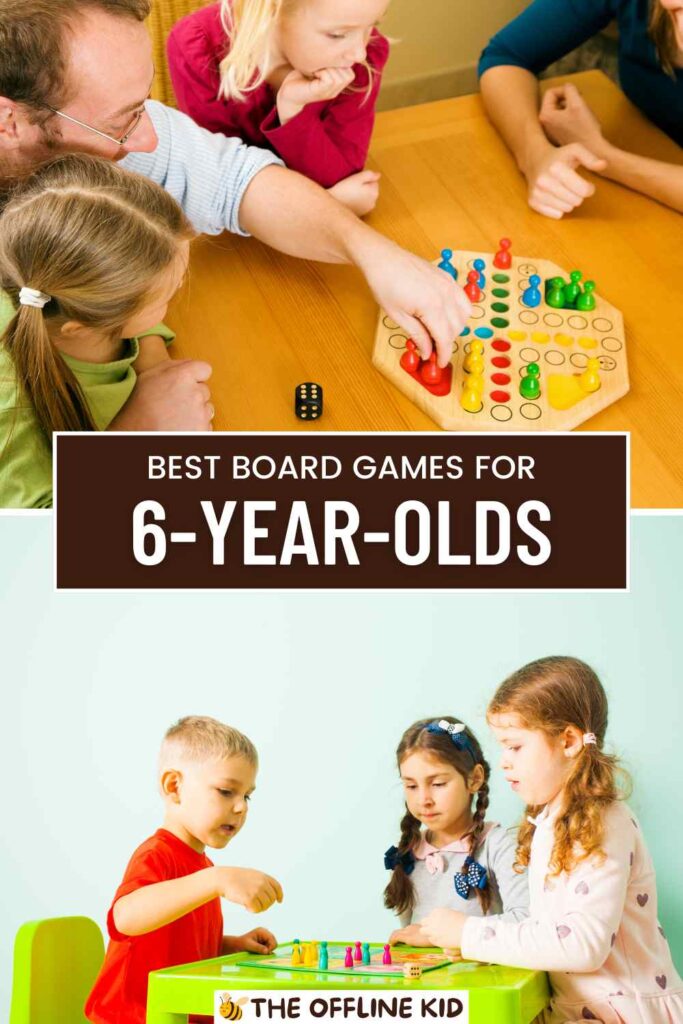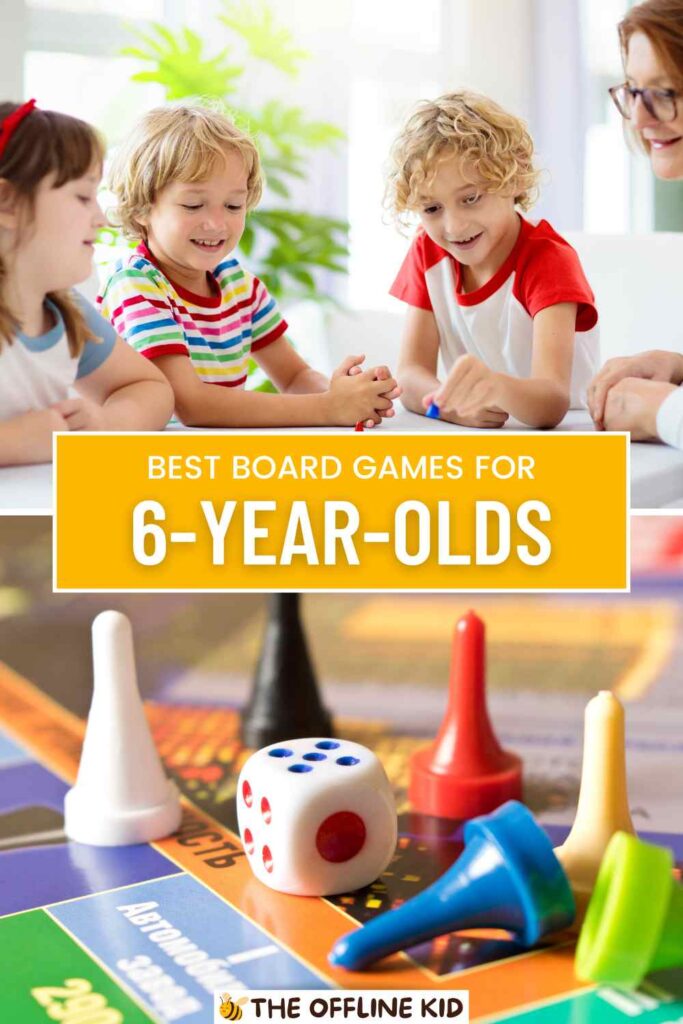Board games offer countless benefits for 6-year-olds, from enhancing cognitive skills to fostering family bonding.
Discover over 25 top board games that are perfect for sparking joy, learning, and togetherness in your child’s life.
Classic Board Games
Candy Land
Description and Gameplay: Candy Land is a simple and colorful game that takes players on a sweet adventure through a magical candy-themed land. The objective is to be the first to reach King Kandy’s Castle by drawing cards and moving along the path.
Why It’s Great for 6-Year-Olds:
- Color Recognition: Children learn to recognize and match colors.
- Simple Rules: Easy for young kids to understand and follow.
- No Reading Required: Ideal for pre-readers.
Chutes and Ladders
Description and Gameplay: Chutes and Ladders is a classic game where players navigate a board of numbered squares, moving forward by spinning a spinner. Climb ladders to advance quickly, but watch out for chutes that send you sliding back!
Educational Benefits:
- Counting Skills: Enhances basic math and counting skills.
- Life Lessons: Teaches about rewards and setbacks in a playful context.
- Patience and Turn-Taking: Encourages waiting for turns and handling setbacks gracefully.
Connect 4
Description and Gameplay: In Connect 4, players take turns dropping colored discs into a vertical grid, aiming to get four in a row horizontally, vertically, or diagonally.
Strategic Thinking for Young Minds:
- Pattern Recognition: Develops the ability to recognize patterns and anticipate moves.
- Critical Thinking: Encourages planning ahead and strategic thinking.
- Competition: Introduces friendly competition in a manageable format.
Sorry!
Description and Gameplay: Sorry! is a fun game where players move their pawns around the board based on card draws, aiming to get all their pieces “home” while sending opponents’ pieces back to start.
Learning about Taking Turns and Patience:
- Strategy: Involves decision-making and risk assessment.
- Social Skills: Promotes turn-taking and patience.
- Fun Interaction: The element of sending opponents back to start adds excitement and interaction.
By introducing your child to these classic board games, you’ll help them develop important skills while providing hours of fun and memorable family moments.
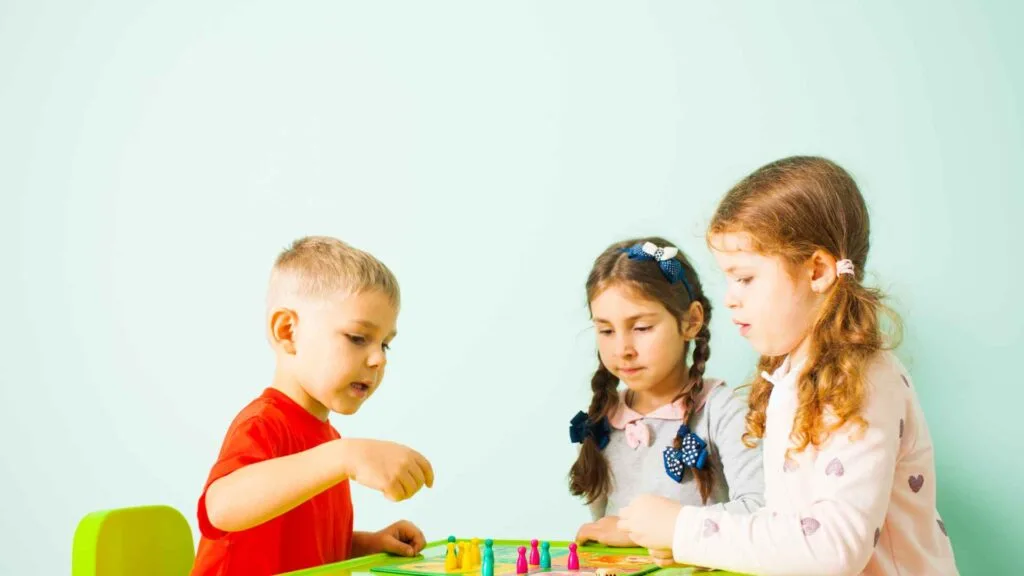
Educational Board Games
Sequence for Kids
Description and Gameplay: Sequence for Kids is a simplified version of the classic Sequence game. Players place animal cards on the corresponding spaces on the board to form sequences of four chips in a row.
Developing Critical Thinking:
- Matching Skills: Enhances the ability to match animals and colors.
- Strategic Planning: Encourages thinking ahead to block opponents and create sequences.
- Team Play: Can be played in teams, promoting cooperation.
Zingo!
Description and Gameplay: Zingo! is a fast-paced matching game that’s similar to Bingo. Players slide the Zinger to reveal tiles and match them to their cards. The first player to fill their card wins.
Enhancing Vocabulary and Matching Skills:
- Word Recognition: Helps with early reading and vocabulary.
- Quick Thinking: Encourages rapid recognition and matching.
- Interactive Play: The Zinger mechanism adds a fun, interactive element.
The Sneaky, Snacky Squirrel Game
Description and Gameplay: In this game, players help their squirrels collect acorns by spinning a spinner and using squirrel-shaped tweezers. The goal is to be the first to collect five acorns.
Fine Motor Skills and Color Recognition:
- Hand-Eye Coordination: Using tweezers helps develop fine motor skills.
- Color Matching: Teaches color recognition and sorting.
- Turn-Taking: Promotes social interaction and turn-taking.
Sum Swamp
Description and Gameplay: Sum Swamp is a math adventure game where players navigate a swamp by solving simple addition and subtraction problems. The first player to reach the end of the swamp wins.
Introduction to Basic Math:
- Math Skills: Reinforces addition and subtraction in a fun context.
- Problem-Solving: Encourages quick mental math.
- Engaging Theme: The swamp adventure theme keeps children engaged.
These educational board games not only provide entertainment but also promote important learning skills, making them a great addition to any family’s game collection.
Cooperative Board Games
Hoot Owl Hoot!
Description and Gameplay: In Hoot Owl Hoot!, players work together to help owls fly back to their nest before sunrise. Players draw color-coded cards and move the owls to the corresponding colored spaces.
Working Together to Win:
- Teamwork: Encourages cooperative play and team strategy.
- Color Recognition: Enhances the ability to recognize and match colors.
- Simple Rules: Easy to understand, making it suitable for young children.
Race to the Treasure!
Description and Gameplay: Race to the Treasure! is a cooperative game where players build a path to collect keys and beat the ogre to the treasure. Players work together to create a path and collect three keys before the ogre gets to the treasure.
Teamwork and Strategy:
- Collaborative Play: Promotes teamwork and collective decision-making.
- Strategic Thinking: Encourages planning and problem-solving.
- Fun Theme: The treasure hunt theme keeps children engaged and motivated.
Outfoxed!
Description and Gameplay: Outfoxed! is a cooperative whodunit game where players work together to find out which fox stole the pie. Using clues and a special evidence scanner, players eliminate suspects and try to catch the culprit before they escape.
Cooperative Deduction Game:
- Deductive Reasoning: Teaches kids to use clues to solve problems.
- Team Play: Emphasizes collaboration and working towards a common goal.
- Interactive Gameplay: The evidence scanner adds a unique interactive element.
Pandemic: The Cure
Description and Gameplay: Pandemic: The Cure is a simplified dice-based version of the popular game Pandemic. Players work together as a team of specialists to treat diseases and find cures before the diseases spread out of control.
Simplified Version of Pandemic for Kids:
- Team Strategy: Focuses on teamwork and strategic planning.
- Problem-Solving: Encourages players to think critically and work together.
- Adaptable Difficulty: Rules can be adjusted to suit younger players.
By incorporating these cooperative board games into playtime, children can learn the value of teamwork and collective problem-solving, all while having fun and achieving common goals.
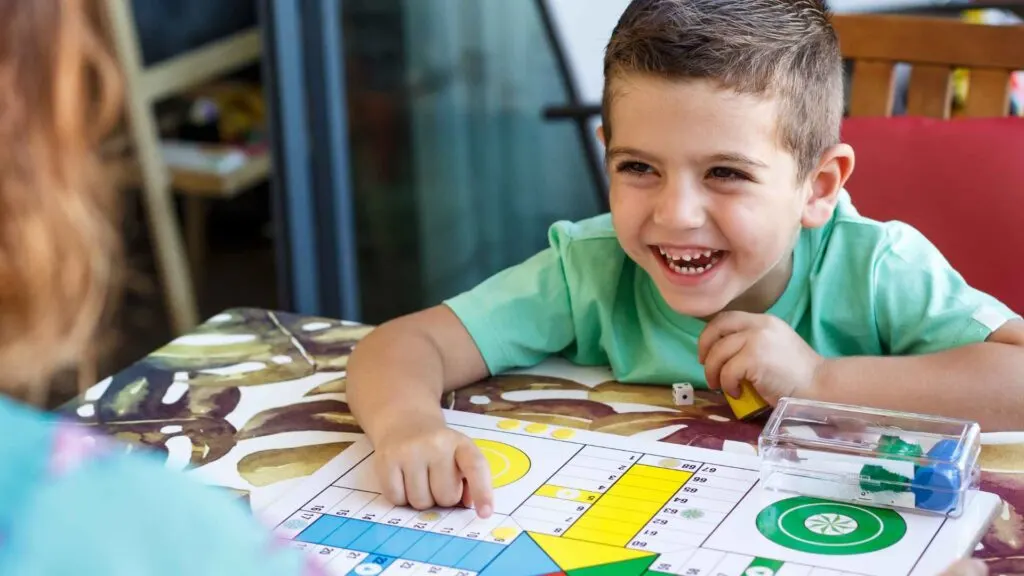
Adventure and Fantasy Board Games
Dragon’s Breath
Description and Gameplay: In Dragon’s Breath, players take on the roles of young dragons trying to collect sparkling stones that fall from an ice column. Each turn, players remove a ring from the ice column, causing stones to fall.
Imagination and Strategic Thinking:
- Fantasy Theme: Engages children’s imagination with dragons and treasures.
- Strategic Planning: Encourages players to think ahead and make strategic choices.
- Fine Motor Skills: Removing rings and collecting stones helps develop fine motor skills.
Labyrinth
Description and Gameplay: Labyrinth is a maze game where players move walls and navigate pathways to collect treasures. The board constantly changes, making each game unique and challenging.
Problem-Solving and Spatial Awareness:
- Dynamic Gameplay: The ever-changing maze keeps the game interesting and challenging.
- Critical Thinking: Enhances problem-solving and spatial awareness.
- Family Fun: Suitable for all ages, making it a great family game.
Magic Maze
Description and Gameplay: Magic Maze is a cooperative game where players control four heroes simultaneously, navigating a shopping mall to steal equipment and escape. The game is played in silence, relying on non-verbal communication.
Collaborative Play and Quick Thinking:
- Teamwork: Emphasizes silent, cooperative play and communication.
- Time Management: Players must think quickly and manage time efficiently.
- Unique Concept: The silent aspect adds a fun and challenging twist.
The Floor is Lava
Description and Gameplay: The Floor is Lava is a physical game where players jump from tile to tile to avoid touching the ground, which is “lava.” The game includes challenge cards that add various tasks to complete.
Physical Activity and Creative Play:
- Active Play: Encourages physical movement and coordination.
- Imagination: Sparks creative play with a fun and engaging theme.
- Challenge Cards: Adds variety and keeps the game exciting.
These adventure and fantasy board games ignite children’s imagination and encourage them to think creatively and strategically. They provide a wonderful mix of fun and learning, making them perfect for young adventurers.
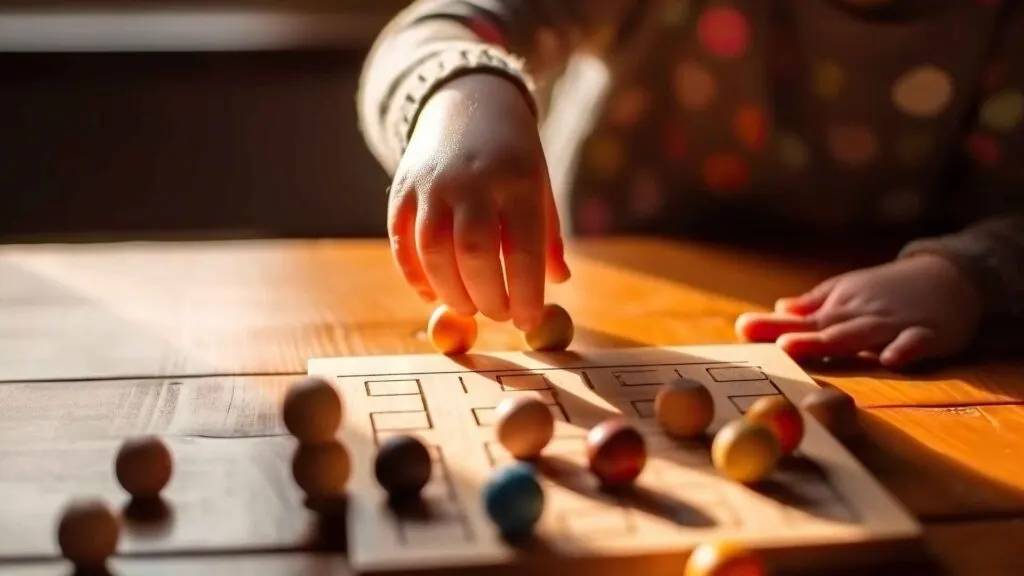
Animal-Themed Board Games
Hisss
Description and Gameplay: Hisss is a colorful card game where players build snakes by matching cards with different snake parts. The goal is to complete as many snakes as possible, and the player with the most completed snakes wins.
Color Matching and Fun Animal Theme:
- Color Recognition: Helps children learn and match colors.
- Pattern Recognition: Encourages recognizing and completing patterns.
- Simple and Fun: Easy rules make it perfect for young children.
Giraffes Can’t Dance
Description and Gameplay: Based on the popular children’s book, this game involves helping Gerald the Giraffe dance by matching cards and completing dance routines. Players collect tokens for each completed dance.
Encouraging Creativity and Coordination:
- Creative Play: Encourages children to use their imagination and creativity.
- Coordination: Helps develop motor skills and coordination through dance moves.
- Storytelling: Connects gameplay with a beloved story, enhancing engagement.
Wildcraft!
Description and Gameplay: Wildcraft! is an educational game where players learn about herbs and their uses while embarking on a wildcrafting adventure. The game is cooperative, and players work together to collect herbs and return home before nightfall.
Learning About Nature and Herbs:
- Educational: Teaches children about various herbs and their benefits.
- Cooperative Play: Promotes teamwork and collaboration.
- Nature-Themed: Engages children with an adventure in the natural world.
Animal Upon Animal
Description and Gameplay: In Animal Upon Animal, players stack wooden animal pieces to build a tower. The goal is to be the first to place all your animals on the tower without it collapsing.
Balance and Dexterity Skills:
- Fine Motor Skills: Develops hand-eye coordination and dexterity.
- Problem-Solving: Encourages strategic thinking to maintain balance.
- Fun and Engaging: The animal theme and stacking challenge keep children entertained.
These animal-themed board games combine fun and learning, making them a delightful choice for young children who love animals. They help develop various skills while providing hours of engaging play.
Quick and Simple Board Games
Spot It!
Description and Gameplay: Spot It! is a fast-paced matching game where players race to find matching symbols on their cards. Each card has a single matching symbol with every other card in the deck.
Quick Reflexes and Observation:
- Observation Skills: Enhances the ability to quickly identify matching symbols.
- Fast-Paced Fun: Keeps children engaged with quick and exciting gameplay.
- Portable: Small and easy to carry, making it great for travel.
Uno
Description and Gameplay: Uno is a classic card game where players take turns matching a card from their hand with the current card shown on top of the deck, either by color or number. Special action cards add twists and excitement.
Color and Number Recognition:
- Simple Rules: Easy to learn and play, perfect for young children.
- Strategic Thinking: Encourages planning and strategy with action cards.
- Family Fun: Suitable for all ages, making it a great game for family time.
Guess Who?
Description and Gameplay: In Guess Who?, players take turns asking yes or no questions to eliminate characters and guess their opponent’s mystery character. The first player to guess correctly wins.
Deductive Reasoning:
- Questioning Skills: Teaches children to ask strategic questions.
- Logical Thinking: Encourages deductive reasoning and process of elimination.
- Interactive Play: Engages children in fun, face-to-face interaction.
Pop the Pig
Description and Gameplay: Pop the Pig is a suspense-filled game where players feed the pig hamburgers until his belly pops. Players roll the die to determine how many times to press the pig’s head.
Counting and Anticipation:
- Counting Skills: Helps children practice counting and number recognition.
- Fine Motor Skills: Pressing the pig’s head develops hand strength and coordination.
- Exciting and Fun: The anticipation of the pig popping keeps children thrilled.
These quick and simple board games are perfect for short play sessions and are easy for young children to understand. They offer a blend of fun and educational value, making them ideal for family game time.
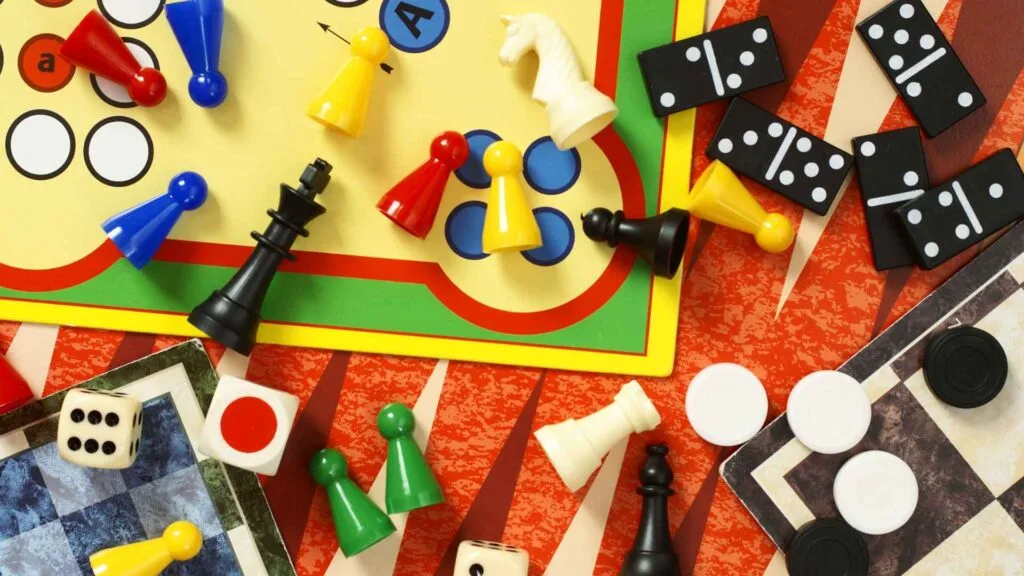
Strategy and Logic Board Games
Ticket to Ride: First Journey
Description and Gameplay: Ticket to Ride: First Journey is a simplified version of the classic Ticket to Ride game. Players collect train cards and claim routes on the map to connect cities and complete tickets.
Introduction to Strategy Games:
- Map Reading: Helps children learn geography and map skills.
- Strategic Planning: Encourages thinking ahead and planning routes.
- Family-Friendly: Simplified rules make it accessible for young children.
Qwirkle
Description and Gameplay: Qwirkle is a tile-based game where players match colors and shapes to create rows and columns. The goal is to score the most points by creating lines of matching tiles.
Matching and Strategy:
- Pattern Recognition: Enhances the ability to recognize and match patterns.
- Strategic Thinking: Encourages players to think ahead and maximize points.
- Simple and Engaging: Easy to learn and fun for all ages.
Blokus
Description and Gameplay: Blokus is a spatial strategy game where players take turns placing their pieces on the board, aiming to fit as many of their pieces as possible while blocking opponents.
Spatial Reasoning and Strategy:
- Spatial Awareness: Develops spatial reasoning and planning skills.
- Strategic Blocking: Teaches strategic thinking and planning ahead.
- Colorful and Fun: The colorful pieces and engaging gameplay keep children entertained.
Mousetrap
Description and Gameplay: Mousetrap is a classic game where players build a contraption piece by piece, aiming to trap their opponent’s mouse. The first player to complete the trap and catch a mouse wins.
Fun with Cause and Effect:
- Engineering Skills: Introduces basic engineering and cause-and-effect concepts.
- Problem-Solving: Encourages strategic thinking and planning.
- Interactive Play: The building aspect adds a hands-on, interactive element.
These strategy and logic board games provide a great way for children to develop critical thinking and problem-solving skills. They offer a perfect balance of fun and education, making them excellent choices for young minds.
Honorable Mentions
Go Fish
Description and Gameplay: Go Fish is a classic card game where players ask each other for specific cards to make pairs. The goal is to collect the most pairs of cards by the end of the game.
Card Game for Memory and Matching:
- Memory Skills: Enhances memory and recall abilities.
- Social Interaction: Encourages communication and social skills.
- Simple and Fun: Easy to learn and enjoyable for young children.
Memory Game
Description and Gameplay: The Memory Game involves flipping over cards to find matching pairs. Players take turns flipping cards and trying to remember their locations to make matches.
Enhancing Memory Skills:
- Memory Development: Strengthens memory and concentration.
- Pattern Recognition: Helps with recognizing and remembering patterns.
- Turn-Taking: Promotes patience and turn-taking.
Jenga
Description and Gameplay: Jenga is a tower-building game where players take turns removing one block at a time from a tower and placing it on top. The game ends when the tower collapses.
Fine Motor Skills and Patience:
- Dexterity: Develops fine motor skills and hand-eye coordination.
- Patience and Precision: Encourages careful and deliberate actions.
- Excitement: The anticipation of the tower falling adds thrill and excitement.
Hungry Hungry Hippos
Description and Gameplay: In Hungry Hungry Hippos, players control hippos that try to eat as many marbles as possible. The player whose hippo eats the most marbles wins.
Fast-Paced and Fun:
- Quick Reflexes: Enhances hand-eye coordination and quick reflexes.
- Competitive Play: Introduces friendly competition in a fun way.
- Simple Rules: Easy for young children to understand and enjoy.
These honorable mentions include a mix of card games and physical games that offer quick, enjoyable play sessions. They are perfect for short bursts of fun and learning, making them great additions to any game collection for 6-year-olds.
Concluding The Best Board Games For 6-Year-Olds
From enhancing cognitive skills like problem-solving and strategic thinking to fostering social skills such as teamwork and communication, board games provide a holistic learning experience.
They also strengthen family bonds, creating precious moments of connection and joy.
When choosing board games for 6-year-olds, consider the interests and developmental needs of your child. Opt for games that are age-appropriate, engaging, and offer educational value.
Whether it’s a classic game like Candy Land or a strategic game like Ticket to Ride: First Journey, the key is to ensure that the game is fun and enjoyable for the whole family.
Tips for Parents
How to Choose the Right Board Game for Your Child:
- Age Appropriateness: Ensure the game is suitable for your child’s age and skill level.
- Interests: Select games that match your child’s interests, whether it’s animals, adventure, or strategy.
- Educational Value: Look for games that offer learning opportunities, such as enhancing math skills or promoting teamwork.
Encouraging a Positive Gaming Environment:
- Set Clear Rules: Establish and explain the rules before starting the game to avoid confusion.
- Encourage Fair Play: Teach your child the importance of taking turns and playing fairly.
- Praise Effort: Focus on effort and participation rather than just winning.
